Texas Roadhouse CEO Jerry Morgan ended the company’s Q4/full-year earnings call Thursday evening with an enthusiastic “Yeehaw.”
Given the company’s results, this didn’t seem out of place at all. For Q4, the Louisville, Ky.-based casual dining company’s comp sales were up 9.9% at company-owned restaurants and 8.9% at domestic franchise restaurants. Those comp sales were driven by 5.1% traffic growth and a 4.8% growth in average check. By month, comp sales were up 9.2% in October and November, and 11.1% in December.
Restaurant margin dollars increased by 21.4% to $176.7 million versus $145.6 million in the year prior, primarily driven by sales. Restaurant margins were up to 15.3%, or 75 basis points higher year-over-year. The company opened 12 company restaurants and seven franchised restaurants during the quarter.
Finally, average weekly sales at company restaurants were $141,653, of which $17,793 — or 12.6% — were to-go sales as compared to average weekly sales of $130,176, of which $16,414 were to-go sales in the prior year. Last quarter, to-go sales surpassed $17,000 a week. The off-premises channel has become a bigger focus in recent quarters as the company has inched back up after coming down from its Covid peak. Notably, the company doesn’t offer delivery. Executives credited the off-premises growth to better staffing levels and operators becoming used to higher volumes.
“At this time, to-go has become a $1 million business per restaurant, with additional room for growth,” Michael Bailen, head of investor relations, said during the call.
That’s not to take away from the core dine-in business, however. Texas Roadhouse restaurants were the busiest they’ve ever been in 2023, according to CFO Chris Monroe, which pushed average unit volumes above $7.6 million for the first time. Because of this higher demand, the company has adjusted its investment strategy.
“While sales volumes at new Texas Roadhouses increase, so did the average investment cost in 2023. Part of this was inflationary pressure on building costs that the industry faced, but it was also due to our strategic investment in building a larger prototype to be able to serve even more guests,” Monroe said.
Those new prototypes include dedicated to-go areas and more room in the back of house to serve higher volumes. It’s about 10% bigger than the company’s pre-Covid prototype and Monroe said the returns on investment exceed the cost of capital required.
Texas Roadhouse is also investing more in technology, with about 200 restaurants deploying digital kitchen systems this year, which executives noted have several benefits.
“It’s about the efficiency of the kitchen and the way the kitchen organizes through screens versus tickets. It creates a lot less chaos. There are only 40 or 50 in (now), but we’re very committed. Every indicator we have, as a kitchen guy, I see communication, consistency, it’s just organized so people don’t stress out about having a bunch of tickets,” Morgan said.
Bailen added that less chaos leads to happier employees which could improve turnover. It also benefits the front of house.
“We have found the digital kitchen does time food out a little better, so appetizers get out a little quicker and entrees get out a little quicker,” he said. “Couple that with our Roadhouse Pay, which is speeding up the check and change portion of the dining experience, and then maybe you have shortened table time.”
The intention is to get the entire system outfitted with the digital kitchen systems, but there is no set date for a full rollout. Jaggers and Bubba’s systems have the systems in place, while all new builds will require the system as well. Speaking of new builds, the company opened a record 30 restaurants in 2023, including 22 Texas Roadhouse locations, five Bubba’s 33 locations, and five Jaggers locations. The company plans to maintain this pace in 2024, with approximately 30 new restaurants across its three brands.
The company will also take a 2.2% pricing increase at the beginning of Q2 to help offset food and wage inflation. The company’s pricing actions come after most of its peers have taken such actions and were considered alongside operators with competitive trends, traffic trends, and stage-mandated labor increases in mind.
“This level of detail, we’re confident we’re taking the right approach,” Monroe said.
The company perhaps has some leverage here, bucking the industry’s overall traffic trends, which were negative in Q4, and as more consumers show trade down activity. Conversely, Texas Roadhouse’s consumers haven’t shown any changes in behavior, including in the first 50 days of Q1.
“We are very excited about what we’re seeing at all of our brands. The consumer does not seem to have changed … that can be seen by traffic growth,” Bailen said. “We continue to see guests trading into us from other fast casual or casual diners. Some of those are going more toward the value side of our menu, but we feel very happy with the consumer right now.”
Full year 2023 by the numbers
- Comparable restaurant sales increased 10.1% at company restaurants and increased 9.8% at domestic franchise restaurants;
- Average weekly sales at company restaurants were $143,837 of which $18,088 were to-go sales as compared to average weekly sales of $131,802 of which $17,504 were to-go sales in the prior year;
- Restaurant margin dollars increased 12.8% to $708.0 million from $627.5 million in the prior year primarily due to higher sales. Restaurant margin, as a percentage of restaurant and other sales, decreased 36 basis points to 15.4% primarily due to commodity inflation of 5.6%, wage and other labor inflation of 6.6% and higher general liability insurance expense partially offset by higher sales;
- 30 company restaurants and 15 franchise restaurants were opened.
Contact Alicia Kelso at [email protected]





